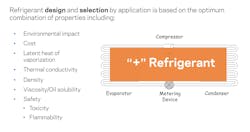Commercial Refrigeration Retrofits and the Newer Refrigerants: Some Basic Tips
The U.S. government's AIM Act requires there be an 85 percent reduction in the manufacture and use of hydrofluorocarbons (HFC) over the next 15 years.
In accordance with the directive, refrigerant producers have been working well in advance of the deadline and are now offering refrigerants with lower global warming potentials (GWP) for both residential and commercial refrigeration needs.
The application of these refrigerants in existing commercial refrigeration systems will require some modifications to the system.
We spoke with Brandon Marshall, North American marketing manager for The Chemours Company, about the key points to be addressed for retrofits.
"For many years, the supermarket industry has had a broad array of solutions that have been available to them, by Chemours and others, that fall into the lower GWP realm," Marshall said.
Marshall said gasses such as R-404A and R-507 are not going to be advantageous for the industry as it moves through the phase down. Price and availability of these refrigerants may change as we progress through the next 15 years, especially when one considers the GWP of R-404A, at just above 3900 (3922 AR4).
“It’s going to be very challenging to produce and import at large volumes high GWP HFCs as we progress through the phase down based on the allocations issued by the US EPA as part of their October ruling," he said.
Marshall said Chemours is recommending that end users who make up the cold storage, retail, and food processing market begin to evaluate their refrigerant footprints with their contracting partners and with their design and engineering partners, to determine what systems can be applicable for a retrofit to a product such as Chemours Opteon™ XP40 (R-449A), or in some cases Opteon™ XP10 (R-513A).
Retrofitting to lower GWP products will alleviate end user’s future concerns related to the availability of a legacy product such as R-404A, and also provide them with efficiency benefits.
"In the case of Opteon™ XP40, with retrofits that we’ve seen—primarily in the supermarket sector where we've performed case studies in stores that have gone through a proper retrofit and recommissioning process—users have seen a 5 to 12 percent energy savings annually. This is a nice benefit when you think about reducing your operating expenses," Marshall said. “Depending on what product you have installed today we're advocating for users to retrofit to Opteon™ XP40 (R-449A) and Opteon™ XP10 (R-513A), where possible.
For entirely new system installations between now and 2026, Marshall suggests contractors and end users have a look at the next-generation, low GWP A2L (mildly flammable) refrigerant solutions. If you have a system that you installed a couple of years ago and you're looking to get a 20-year life out of it, that is a perfect candidate for a retrofit.
"The primary reason for that is, all of the next generation products that are going to be below 150 or below 300 GWP are going to be in that A2L safety designation.Retrofit Requirements
The technical gymnastics of a commercial refrigeration retrofit are relatively simple, but nonetheless essential.
"For a commercial refrigeration retrofit, you may be able to utilize the compressors that are on site," Marshall advised. "You may also be able to utilize the expansion valves that are on site if everything's sized correctly, especially if you're going from R-404 to Opteon™ XP40 (R-449A). In many cases, you'll only have to perform minimal component changes: changing out the suction line filter-dryers, as a best practice; performing an oil change on the system as you go through the retrofit; and then also changing the elastomeric seals that are in the system are all examples of common steps that must be taken. Any of those materials that may be there have the opportunity to absorb oil or may be holding a small amount of refrigerant that became absorbed into that material over time.
“So, in many cases, commercial refrigeration system retrofits—especially between an R-404A and a product like XP40 (R-449A) —can be very straightforward, without a lot of system changes.”
"When retrofitting from R-404 and R-507 to Opteon™ XP-40, there is a higher discharge temperature. You'll want to check where that compressor can operate to ensure that it's within the proper range for the maximum allowable discharge temperature. In many cases, you'll find the expansion devices and the valves on site can be used, and they may just need some adjustments, possibly a couple turns on the stem; and that's mainly because a product like an XP40 has a lower mass flow versus a product like R-404A."
XP-10 Retrofit Guide: https://bit.ly/XP10retrofitguide
XP-40 Retrofit Guide: https://bit.ly/XP40retrofitguide
Chemours Refrigerant Expert tool: https://bit.ly/ChemoursCRE
He continued to say the refrigeration technician will have to do some verification of line sizing.
"In a supermarket or in some larger commercial installations, you can have a section of liquid line or suction line that runs quite a distance, possibly several hundred"But in many cases, we've found that you don’t have to modify the line sizing, which is a huge benefit for the end user, as you don't need to tear out all the piping “
"When you think about a condenser and evaporator, should look at making adjustments, and we highly recommend looking at making adjustments to evaporator pressure regulating valves (EPR valves)and expansion valves . It's very commonplace in supermarkets to have EPRs on the cases. Additionally, we recommend you check any parameters on the controls. Make sure that if you are using electronic controls, electronic expansion valves, and electronic pressure sensors, that they are using the correct refrigerant, because there are temperature and pressure differences between R-404 and an Opteon™ XP40. But again, usually that just involves modifying a setting."
Editor’s note: This article covers products from one refrigerant producer, however we realize end-user brand selections will vary.
SEE SIDEBAR BELOW
On the Residential Side
The challenge that the air conditioning market's going to have, said Brandon Marshall, is that there is no retrofit solution today for R-410A. This means that contractors, especially on the air conditioning side, are going to need to pay special attention to when their preferred manufacturers are starting to switch over to next-generation products like Opteon™ XL41, which is R-454B.
"As it stands now, we don't see a retrofit solution in the marketplace for R-410A, and we will see the new equipment jumping to A2L-based products, such as R-454B. Because of the safety designation change (R-410A is an A1, with no flame propagation, and R-454B is an A2L, or mildly flammable), they're not going to be ‘drop-in’ replacements."
HVAC equipment is going to have different safety features based on UL 60335-2-40 Standard for Household And Similar Electrical Appliances - Safety - Part 2-40: Particular Requirements for Electrical Heat Pumps, Air-Conditioners and Dehumidifiers, which will need to be in place to use an A2L in that type of application, he said. -TM
About the Author
Terry McIver
Content Director - CB
As director of content for Contracting Business, he produces daily content and feature articles for CB's 38,000 print subscribers and many more Internet visitors. He has written hundreds, if not two or three, pieces of news, features and contractor profile articles for CB's audience of quality HVACR contractors. He can also be found covering HVACR industry events or visiting with manufacturers and contractors. He also has significant experience in trade show planning.



